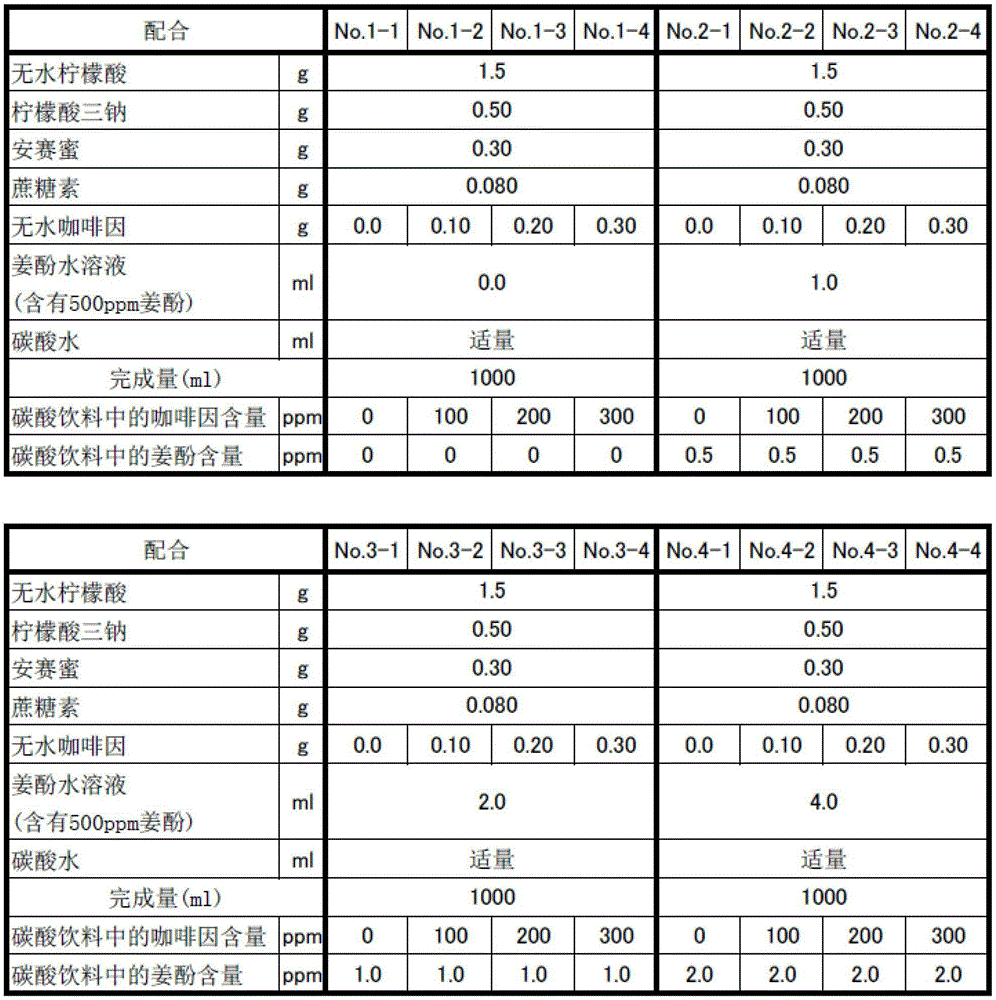carbonated beverages containing caffeine
A carbonated beverage, caffeine technology, applied in application, food preparation, food science and other directions, can solve problems such as poor refreshing taste and bad taste, and achieve the effect of high liking and inhibiting bitter taste.
- Summary
- Abstract
- Description
- Claims
- Application Information
AI Technical Summary
Problems solved by technology
Method used
Image
Examples
Embodiment
[0042] Hereinafter, the present invention will be explained in further detail through examples, but the present invention is not limited to these examples.
[0043]
[0044] In the following example, gingerol and caffeine are quantified by filtering the beverage as a sample with a membrane filter (acetate cellulose filter membrane 0.45 μm made by Japan ADVANTEC) and then injecting it into HPLC. The measurement conditions are as follows.
[0045] (HPLC measurement conditions)
[0046] ·Column: TSK-gelODS-80TsQA (4.6mmφ×150mm, Tosoh Corporation)
[0047] ·Mobile phase: A: water: trifluoroacetic acid = 1000: 0.5
[0048] B: Acetonitrile: Trifluoroacetic acid = 1000: 0.5
[0049] ·Flow rate: 1.0ml / min
[0050] ·Column temperature: 40℃
[0051] ·Gradient conditions:
[0052] Keep A:B=95:5 from the beginning of the analysis to 5 minutes later,
[0053] 5 minutes to 20 minutes A: B=5: 95,
[0054] Keep A:B=5:95 until 20 minutes to 25 minutes,
[0055] From 25 minutes to 26 minutes A: B=95: 5,
[0056...
Embodiment 1
[0064] Example 1: Preparation of carbonated beverage with gingerol (1)
[0065] According to the formula in Table 1, mix with anhydrous citric acid, trisodium citrate, high sweetness sweeteners (sucralose and acesulfame potassium), anhydrous caffeine, add gingerol aqueous solution, and mix with high-pressure carbonated water. Preparation pH3.3 (after degassing) and gas pressure 3.5kg / cm 2 (20℃ converted) non-calorie carbonated beverage. The contents of gingerol in carbonated beverages of the prepared carbonated beverages (No. 1 to No. 4) were 0, 0.5, 1.0, and 2.0 ppm, respectively. After the carbonated beverage was cooled to 5°C, sensory evaluation was conducted by professional judges. The evaluation is based on the following: the intensity of bitterness caused by caffeine and carbonic acid (3 points: strong bitterness and not suitable for drinking, 2 points: slightly bitter but drinkable, 1 point: weak bitterness is felt, 0 point: no bitterness) Refreshing taste and aftertaste...
Embodiment 2
[0071] Example 2. Preparation of carbonated beverage with ginger extract (1)
[0072] As the ginger extract, a fragrance (ginger flavor) prepared by blending a ginger extract obtained by supercritical carbon dioxide extraction was used. The content of gingerol in ginger flavor is 0.1%. Use the following method to prepare a total of 1000mL and a gas pressure of 3.5kg / cm 2 Non-calorie carbonated beverages (converted at 20°C): with 1.5g anhydrous citric acid, 0.5g trisodium citrate, high sweetness sweetener (0.08g sucralose, 0.3g acesulfame potassium), add caffeine 5 After level (0, 50, 150, 300, 600ppm) and ginger flavor 4 level (0, 0.05, 0.10, 0.30%), mix high-pressure carbonated water. And the pH of carbonated drinks is 3.3 (measured after degassing) (sweetness 10.8 degrees). The carbonated beverage was cooled to 5°C, and three professional judges evaluated the intensity of bitterness, the refreshing aftertaste, and the refreshment as a carbonated beverage by evaluation points ...
PUM
 Login to View More
Login to View More Abstract
Description
Claims
Application Information
 Login to View More
Login to View More - R&D
- Intellectual Property
- Life Sciences
- Materials
- Tech Scout
- Unparalleled Data Quality
- Higher Quality Content
- 60% Fewer Hallucinations
Browse by: Latest US Patents, China's latest patents, Technical Efficacy Thesaurus, Application Domain, Technology Topic, Popular Technical Reports.
© 2025 PatSnap. All rights reserved.Legal|Privacy policy|Modern Slavery Act Transparency Statement|Sitemap|About US| Contact US: help@patsnap.com



